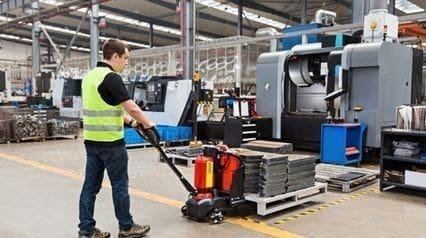What is Material Handling Equipment?
Material handling equipment is a set of tools and systems designed to make it easier and safer to handle, protect, store, and move materials and products. Any organization that needs to store and move bulk material needs material handling equipment.
You will find material handling equipment in many industries as they are versatile and widely used. Warehouses may use this for moving stocks, for handling products in automotive factories, and more.
It’s very important to know what material handling equipment you need for your organization to streamline operations and create a safer environment for employees. This article will be going through everything you need to know about material handling equipment, starting with the types of equipment found in various industries.
Types
Material handling equipment is a broad term. It can refer to forklifts and cranes, but it may also refer to engineered systems like refrigerated warehouses for food stocks. And to give you a better idea of the different material handling equipment and how they are used, this section will explain the types below.
Storage and Handling
These types of equipment are typically used to store and manage products and materials while waiting for another step in the production or distribution process. Some companies may use this equipment for long-term storage, while others only need them for short-term storage. These systems are typically stationary, but it’s common for companies to use them along with automated systems and equipment.
Examples of storage and handling equipment include drawers and shelves, racks, and stacking frames to ensure materials and products are in safe and accessible locations.
Bulk Material Handling
Organizations need bulk material handling equipment to move, store, and control bulk material. Typically, this equipment is used to move and store materials such as food, liquids, metals, and minerals in loose forms. These types of equipment are specifically designed for various purposes, so it’s important to find the right pieces for your needs.
Some examples of bulk material handling equipment include hoppers, conveyor belts, stackers, and reclaimers. Again, this encompasses a wide range of equipment as various industries have their own equipment for bulk material handling.
Engineered Systems
As the name suggests, these are automated systems in place for storing and moving products and materials. These tools usually feature multiple pieces of equipment working together to perform a specific task. These are very popular in many industries as they reduce the need for manual labor and can also speed up the entire production or distribution process.
Some common engineered systems you might find within an organization are conveyor belts, robotic delivery systems, automated vehicles, and automated storage and retrieval systems.
Industrial Trucks
Industrial trucks are used for handling and moving large quantities of materials. This category describes different equipment designed for material transportation, ranging from small hand-operated trucks to driveable equipment like large trucks.
There are two sub-categories of industrial trucks: stackable and non-stackable. The non-stackable trucks are typically only used for transportation. However, stackable industrial trucks can also load and stack materials. Some of the most common industrial trucks include pallet trucks, hand trucks, order pickers, and side loaders.
Safety Regulations
Handling and using material handling equipment comes with certain risks. And to ensure that employees and operators are safe throughout operations, it’s up to the organization to put in safety regulations to ensure that everyone is handling equipment safely and regularly.
Luckily, the Occupational Safety and Health Administration (OSHA) has general safety regulations in place for material handling equipment. That way, it’s easier for organizations to put in the proper controls and mitigations for risks and hazards. These guidelines focus on mechanized equipment and vehicles and require organizations to follow certain standards.
For example, the guidelines require seat belts, rollover protective structures, and emergency access for all material handling vehicles. That way, workers and operators are never faced with unnecessary risks during the job.
Additionally, OSHA requires organizations to follow these guidelines. But if you are dealing with material handling equipment out of the United States, these rules don’t apply. Instead, you should consult the laws in your locality or place of operations for handling this type of equipment to ensure compliance.
Improve your EHS Management
Cultivate a safe working environment and streamline compliance with our EHS solutions.
Explore nowHow to Maintain Material Handling Equipment
If you want your material handling equipment to perform properly and last longer, it’s important to practice proper and regular maintenance. All material handling equipment requires maintenance, and failing to maintain the equipment can result in safety hazards, accidents, and malfunctioning equipment.
Every piece of material handling equipment contains its own set of maintenance instructions. So, it’s important to apply maintenance as required by the equipment. That said, some of the key ways organizations maintain their material handling equipment include:
- Conducting regular equipment inspections
- Scheduling equipment maintenance checks
- Ensuring that all operators receive adequate training
- Upgrading equipment as necessary
FAQs about Material Handling Equipment
Material handling equipment is typically used for moving, storing, and protecting an organization’s various materials and goods. These are used throughout the entire process, from production down to distribution.
There are many materials that require specific handling equipment, including:
- raw materials;
- food products;
- minerals;
- liquids; and
- other products that an organization produces.
Material handling refers to the movement, storage, and protection of goods by an organization. To perform this, organizations need to use specific equipment designed for their materials.
Material handling equipment is widely used by many industries that need to store and move materials, such as:
- aerospace;
- automotive;
- distribution;
- warehousing; and
- manufacturing.




